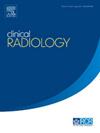使用中间导管内导丝支持经桡动脉栓塞颅内动脉瘤
IF 1.9
3区 医学
Q2 RADIOLOGY, NUCLEAR MEDICINE & MEDICAL IMAGING
引用次数: 0
摘要
目的本研究的目的是探讨采用中间导管内导丝支持经桡动脉通路栓塞颅内动脉瘤的安全性和效果。材料与方法回顾性分析50例患者,年龄53.2±8.9岁,年龄范围:35 ~ 82岁,颅内动脉瘤57例。对临床资料、治疗及随访结果进行分析。结果动脉瘤破裂14例(28%),动脉瘤大小2 ~ 12(6.8±1.6)mm,经桡动脉通道行血管内治疗42例(84%),左侧8例(16%)。17例(34%)患者单独进行了线圈栓塞,其中14例(28%)患者使用单根微导管,3例(6%)患者使用双根微导管。40例(80%)宽颈动脉瘤患者接受支架辅助盘绕治疗,其中36例(72%)患者使用微导管,4例(8%)患者使用双微导管。46例(92%)患者使用0.018英寸导丝,其余4例(8%)患者使用0.035英寸导丝。栓塞后立即,48例(84.2%)动脉瘤实现了Raymond I级栓塞,8例(14.0%)动脉瘤实现了II级栓塞,1例(1.8%)动脉瘤实现了III级栓塞。1例(2%)患者桡动脉穿刺无症状闭塞。32例(64%)35例(61.4%)动脉瘤患者接受了血管造影随访,其中32例(91.4%)动脉瘤为Raymond I级闭塞,3例(8.6%)动脉瘤为II级闭塞。结论经桡动脉通路采用中间导管技术加内导丝支撑治疗颅内动脉瘤是安全有效的。本文章由计算机程序翻译,如有差异,请以英文原文为准。
Use of an intermediate catheter with internal guide wire support for transradial embolisation of intracranial aneurysms
Aim
The aim of this study was to investigate the safety and effect of the technique using an intermediate catheter with internal guide wire support for embolisation of intracranial aneurysms through the transradial access.
Materials and methods
Fifty patients aged 53.2 ± 8.9 (range: 35-82) years with 57 intracranial aneurysms were retrospectively enrolled. The clinical data, treatment, and follow-up outcomes were analysed.
Results
Aneurysm rupture was found in 14 (28%) patients, with aneurysm size ranging 2 to 12 (6.8 ± 1.6) mm. Endovascular treatment was performed through the transradial access on the right in 42 (84%) patients and on the left in 8 (16%). Coil embolisation alone was conducted in 17 (34%) patients, including use of a single microcatheter in 14 (28%) patients and double microcatheters in 3 (6%). Stent-assisted coiling was performed for wide-necked aneurysms in 40 (80%) patients, including use of a microcatheter in 36 (72%) patients and double microcatheters in 4 (8%). A 0.018-inch guide wire was used in 46 (92%) patients, and a 0.035-inch guide wire was used in the rest 4 (8%). Immediately after embolisation, Raymond grade I embolisation was achieved in 48 (84.2%) aneurysms, grade II in 8 (14.0%), and grade III in 1 (1.8%). One (2%) patient had nonsymptomatic occlusion of the punctured radial artery. Thirty-two (64%) patients with 35 (61.4%) aneurysms had angiographic follow-up, including Raymond grade I occlusion in 32 (91.4%) aneurysms and grade II in 3 (8.6%).
Conclusion
Use of the intermediate catheter technique with internal guide wire support through the transradial access is safe and effective in endovascular embolisation of intracranial aneurysms.
求助全文
通过发布文献求助,成功后即可免费获取论文全文。
去求助
来源期刊

Clinical radiology
医学-核医学
CiteScore
4.70
自引率
3.80%
发文量
528
审稿时长
76 days
期刊介绍:
Clinical Radiology is published by Elsevier on behalf of The Royal College of Radiologists. Clinical Radiology is an International Journal bringing you original research, editorials and review articles on all aspects of diagnostic imaging, including:
• Computed tomography
• Magnetic resonance imaging
• Ultrasonography
• Digital radiology
• Interventional radiology
• Radiography
• Nuclear medicine
Papers on radiological protection, quality assurance, audit in radiology and matters relating to radiological training and education are also included. In addition, each issue contains correspondence, book reviews and notices of forthcoming events.
 求助内容:
求助内容: 应助结果提醒方式:
应助结果提醒方式:


